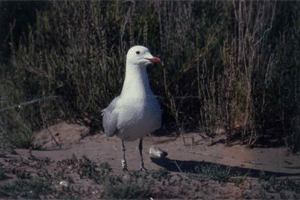Aims:
1. To develop estimates of the reproducing population and analyse the
population
by matrix modelling and environmental stochasticity.
2. To develop estimates of demographic parameters by capture/re-capture
I. fertility
II. areas inhabited
III. survival of adults
Analysis of trophic ecology applying methodology of stable
isotopes. Results within the frame of the western Mediterranean, from
where simultaneous data on a considerable number of population groups
is available.
3. To establish the level of contamination due to heavy metals, specially
mercury
(Hg).
5.- Analysis of the colonization turnover and the extinction of populations
in marine SCI areas in the Balearics, using chronological historic series
and Markov chains.
6.-PVA (Population Viability Analysis) and REA (Risk Extinction Assessment).
Methodology : matrix modelling, Monte Carlo simulations.
7. To end by diagnosing the state of conservation of the two species and
their relation to Posidonia fields.
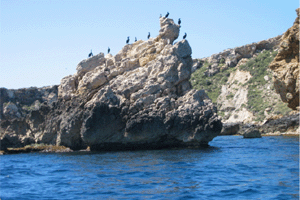
Development:
During the years spanned by this project the population of these species
has been studied both in terms of number and demographic variables. Individuals
and reproducing couples have been identified, observed at a distance,
marked and the plastic markings read at a distance, and other procedures
have also been used. Almost all the aims proposed have been fulfilled.
Results:
The evolution in the number of reproducing couples for the whole
of the Balearic Archipelago, taking into account only the years in which
a full census count was carried out, is reflected in the following graph.
For the year 2003 during which a census count in Minorca was not carried
out, an approximation is offered based on the couples counted on the previous
year. The progressive decrease in reproducing couples detected in 2002
continues.
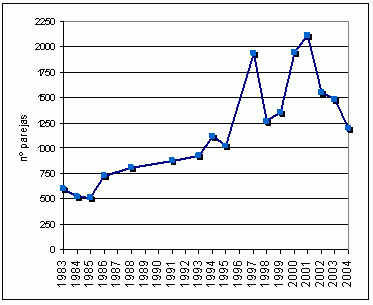
Fig. 1 : Reproducing couples of Larus audouinii in the Balearics since 1983.
In the census counts per islands, in the period between 2003 and 2004 it was observed that the decrease in the number of birds nesting in the Balearics in 2004 was of similar proportions on the three islands. (Table 2).

Table 1 : Results of census counts of Audouin Seagull in the period between 2002 and 2004.
In relation to the data compiled on reproductive parameters, the comparison on the proportion of nests corresponding to each different lay size in the different breeding areas between 2002 and 2004 is reflected in the following figure:
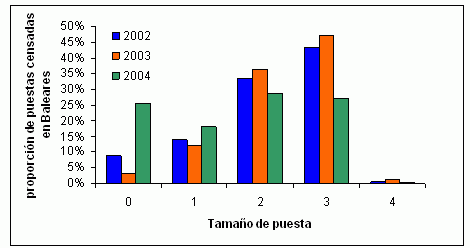
Fig.2: Proportion of nests of each lay size counted in the Balearics in the years 2002, 2003 and 2004.
It was clearly observed in the first two years, 2002
and 2003, that there was a progressive increase in the proportion of nests
the more the size of the lay increased. Nevertheless, during the counting
in 2004 it was observed that there was an increase in the number of zero
lays in detriment of the lays of three which are usually the most common
in this species. A delay in the phenology of the laying had already been
observed in 2003 in comparison with 2002 (and was so specified in this
same report corresponding to the year 2003), but this delay does not affect
the proportion of different sized lays. During the 2004 count it had also
been noticed that the laying in some colonies had been more delayed than
on the previous year. The adverse climate conditions of the spring of
2004 may have influenced this delay, although the direct causes have not
as yet been determined. There is sure evidence that some lays were lost
due to storms on the Illa de l’Aire (island), where some groups
did not recover after the loss of the first lays (R.Escandell, personal
communication).
As for the Common Shag Cormorant, the methodologies applied and efforts
made were different on each year, but, in general terms, there does seem
to be a progressive annual decrease in the number of nesting couples.
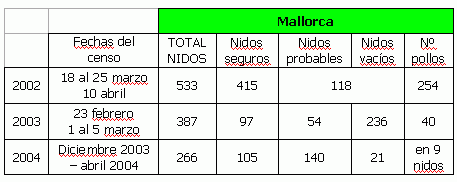
Table 2: Comparison of the census results of Phalacrocorax aristotelis in the period comprising 2002-2004 on the island of Majorca.
As data collected throughout a long series of years is not available, it could be that the point of departure , which was the census count of the year 2002, was in fact exceptionally good and that, therefore, the actual present number of couples is more similar to the number counted in the last two years. In any case, and in order to obtain more accurate results, the assessment of more years is required.
During 2002 and 2003 data from the Pityuses (Pine Islands:
Ibiza, Formentera and islets) were forthcoming , but as the areas covered
were not the same, the only comparison available is for the island of
Majorca on which continuous data from the last three years is available.
Information on nest location has been stored in digital form.
As was mentioned before, neither the methodologies applied nor the efforts
made were homogenous during all the years. That is the reason why it was
decided to re-compile census information on the 10 x 10 km base grid of
the UTM projection over Majorca. Results are shown according to years
and category of nests: sure nests, i.e. counted each year and bearing
evidence of breeding (either because chicks have been observed or incubating
adults have been seen); and probable nests. To this category both empty
nests and those presenting some sort of evidence that they had been occupied
during that year were added, in order to draw up the map. It has been
observed that the highest density is to be found at the following locations:
the northeast of the island, round Artà, and in the Capes of Pinar
and Formentor. Another important nesting location is on the southeast
of Majorca, south of Cap Enderrocat. During the three years, the southernmost
tip of the island was the least occupied.
